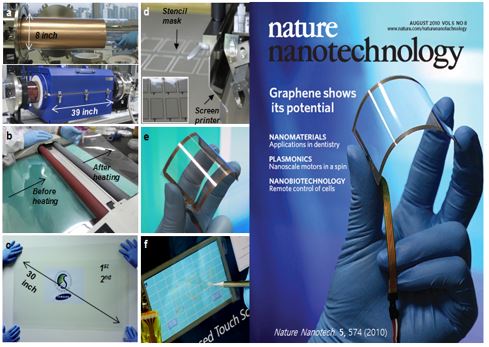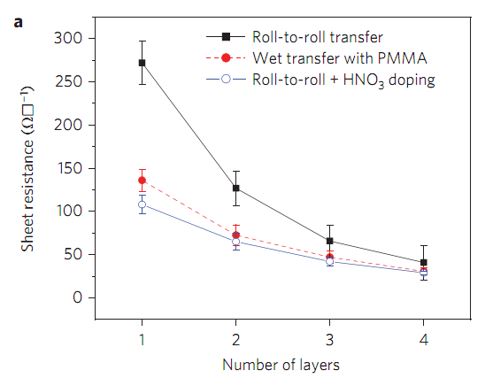Technology Review - R2R
Dilemma in existing graphene researches
Graphene discovered while exfoliating from bulk graphite with mechanical cleavage using Scotch tape in 2004 has excellent electrical conductivity and mechanical characteristics. Owing to its transparent and flexible features, it has been studied widely until now. In spite of such excellent properties, it has been difficult to synthesize graphene en masse, as the mass production technology has not been developed. Thus, it has been difficult to conduct researches on technology which can be applicable actually.
Currently, large area synthesis of graphene is possible with the Chemical Vapor Deposition (CVD) technique developed by a team led by Professor Byung Hee Hong at Seoul National University. However, to apply the material to electronic devices, it is necessary to transfer the graphene on electrode substrates. At present, a widely used method of transferring graphene is wet transfer. In this method, a metal wafer deposited graphene is attached to a PDMS substrate and then immersed into APS etchant to remove the metal wafer. After that, the PDMS is stamped on the desired substrate to transfer the graphene.
In the wet transfer method, as catalytic etching is made by using etchant, it will take a considerable time for etching. When transferring to a large area (4 inches or larger), it is necessary to conduct the graphene layer transferring process on the area through the catalytic etching for more than a day. Issues related to such long duration of the etching process may affect time efficiency and cost effectiveness when producing large quantities of graphene films on an industrial scale, and may cause some difficult problems. Therefore, to apply the graphene layers on an industrial scale, it is required to devise a method of transferring graphene films within a short time frame at low cost on a large area.
Roll-to-Roll Synthesis System
Roll-to-roll (R2R) processing is technology of maximizing productivity by implementing a continuous production line of continuous CVD, printing, exfoliating, etching, transferring and so on, like the process of printing newspapers.
The research team led by Prof. Byung Hee Hong at Sungkyunkwan University (currently worked for SNU) was proposed the concept of synthesizing graphene through the R2R system and implemented it experimentally for the first time.

Fig1. A diagram showing the concept of R2R exfoliation and transfer of graphene as proposed by Prof. Byung Hee Hong (Nature Nanotech. 2010).

Fig2. Photos showing the process of producing graphene transparent electrodes through the R2R process and manufacturing touch screens (resistive type) by using the process (left); and showing the flexibility of a touch screen manufactured in the process (right).
What is R2R production process
For the R2R synthesis, every material can be processed as a flexible film, it is directly linked to the â€کflexible electronics’ process. The R2R system is made possible owing to the flexibility of graphene produced by CVD synthesis and the copper foil on which the graphene is deposited, which save time and costs for the process.
R2R transfer process can be summarized as follows:
(1) Attach polymer support layer to a graphene deposited copper substrate.
(2) Remove copper with etchant.
(3) Separate the graphene sheet from the polymer support layer and transfer it to a desired substrate.
A copper film on which the graphene is deposited is passing through two rollers, and attached to a polymer film with adhesive layer. Next, the copper substrate is removed by electrochemical reaction of APS solution. Finally, the graphene film can be transferred by removing the bonding strength between the graphene and the polymer film. When using Thermal Release Tape (TRT) for a polymer support layer, the film will lose the adhesiveness and detached by applying heat.

Fig3. Sheet resistances of transferred graphene films using a roll-to-roll (R2R) dry-transfer method combined with thermal release tapes and a PMMA-assisted wet-transfer method(Nature Nanotech. 2010)
In the R2R dry transfer process, sheet resistance of the first graphene layer after PMMA coating is 2-3 times higher than that of the wet transfer. However, when the more the number of layers is, the faster the resistance is dropping. The research team assumed that the bonding strength between the first graphene layer and the substrate is not strong enough to detach the graphene film completely from the TRT. As a result, mechanical defects occur and the overall sheet resistance becomes higher. Since the next graphene sheets are not attached to the substrate surface directly, the sheet resistance of multiple graphene layers is not much different from that of the wet transfer.
It is possible to improve electrical properties of graphene film by doping a p-type material via nitric acid. It is more effective in the R2R process. When doping 4-layer graphene sheets with 90% transparency with a p-type material, the sheet resistance is 30خ©, which is much better than that of ITO or carbon nanotubes.
The necessity of R2R continuous production process

Fig 4. An example of R2R continuous system process flow to produce flexible and transparent graphene electrodes (using techniques used to touch screens).
Graphene Square is selling not only the CVD synthesis system, but also R2R systems which can produce high-quality large-area films. In addition, the company is continuously developing R2R dry transfer systems for graphene. Based on such efforts, we hope that graphene, so-called a dream material, will be met in our daily lives.



